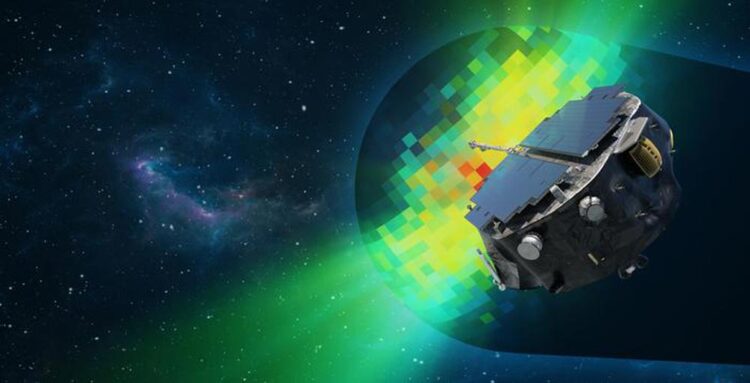NASA’s Interstellar Mapping and Acceleration Probe passes system integration review

IMAP will study the protective magnetic bubble that surrounds our solar system, called the heliosphere, and the particle acceleration that occurs across it.
Credit: NASA/Princeton/Johns Hopkins APL/Josh Diaz
The Interstellar Mapping and Acceleration Probe (IMAP) marked the completion of an important step on the path to spacecraft assembly, test, and launch operations this week at Johns Hopkins Applied Physics Laboratory (APL) in Maryland.
The IMAP team met with a review panel to evaluate the plan for integrating all systems onto the spacecraft, such as the scientific instrumentation, electrical and communication systems, and navigation systems. Successful completion of this System Integration Review (SIR) means that the project can proceed with assembling and testing the spacecraft in preparation for launch. This process is a bit like a carefully choregraphed dance where the instruments and support systems are delivered to different facilities, tested together in chambers in Los Alamos, New Mexico; San Antonio, Texas; and Princeton, New Jersey; and shipped back to be integrated and tested again altogether.
On Friday, Sept. 15, 2023, the chair of the Standing Review Board announced that the IMAP project successfully passed the SIR requirements to proceed to integration and test.
“I am incredibly proud of the entire IMAP team for everyone’s hard work and determination in getting us to and through this critical milestone,” said David McComas, IMAP mission principal investigator and Princeton University professor. “We are now moving on to spacecraft integration and test, where all of the individual subsystems and instruments merge together to create our full IMAP observatory.”
The IMAP mission, which will be ready to launch in 2025, will explore our solar neighborhood, decoding the messages in particles from the Sun and beyond our cosmic shield. The mission will map the boundaries of the heliosphere – the electromagnetic bubble surrounding the Sun and planets that is inflated by the solar wind.
David McComas leads the mission with an international team of more than 20 partner institutions. APL is managing the development phase, building the spacecraft, and will operate the mission. IMAP is the fifth mission in NASA’s Solar Terrestrial Probes (STP) Program portfolio. The Explorers and Heliophysics Projects Division at NASA’s Goddard Space Flight Center in Greenbelt, Maryland, manages the STP Program for the agency’s Heliophysics Division of NASA’s Science Mission Directorate.
For more information about IMAP visit: https://imap.princeton.edu
Media Contacts
Abbey Interrante
NASA/Goddard Space Flight Center
abbey.a.interrante@nasa.gov
Denise Hill
NASA
denise.hill@nasa.gov
All latest news from the category: Physics and Astronomy
This area deals with the fundamental laws and building blocks of nature and how they interact, the properties and the behavior of matter, and research into space and time and their structures.
innovations-report provides in-depth reports and articles on subjects such as astrophysics, laser technologies, nuclear, quantum, particle and solid-state physics, nanotechnologies, planetary research and findings (Mars, Venus) and developments related to the Hubble Telescope.
Newest articles

Innovative 3D printed scaffolds offer new hope for bone healing
Researchers at the Institute for Bioengineering of Catalonia have developed novel 3D printed PLA-CaP scaffolds that promote blood vessel formation, ensuring better healing and regeneration of bone tissue. Bone is…

The surprising role of gut infection in Alzheimer’s disease
ASU- and Banner Alzheimer’s Institute-led study implicates link between a common virus and the disease, which travels from the gut to the brain and may be a target for antiviral…

Molecular gardening: New enzymes discovered for protein modification pruning
How deubiquitinases USP53 and USP54 cleave long polyubiquitin chains and how the former is linked to liver disease in children. Deubiquitinases (DUBs) are enzymes used by cells to trim protein…


